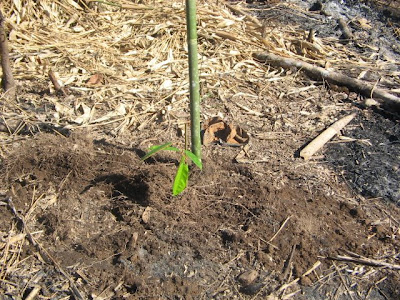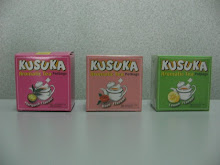
Thursday, December 11, 2008
Monday, December 8, 2008
Usage of durian pulps

Saturday, December 6, 2008
Mangosteen


In P2 there are a few matured mangosteen trees. We will try to preserve them .. perhaps plant a few more ..
Thursday, December 4, 2008
papaya tree
.JPG) Papaya can grow almost anywhere. While a female tree bears fruit, a male tree only flowers. Although flowers can be eaten, most prefer the papaya. From large papaya to small exotica papaya .. some very sweet and others no so sweet. The ones that we are planting at the dusun are smaller fruit with a tougher fruitskin. Supposedly the fruit can last 4 or 5 days after plucking. Very sweet. It takes about 9 months for a papaya tree to mature and bear fruit.
Papaya can grow almost anywhere. While a female tree bears fruit, a male tree only flowers. Although flowers can be eaten, most prefer the papaya. From large papaya to small exotica papaya .. some very sweet and others no so sweet. The ones that we are planting at the dusun are smaller fruit with a tougher fruitskin. Supposedly the fruit can last 4 or 5 days after plucking. Very sweet. It takes about 9 months for a papaya tree to mature and bear fruit.Sunday, November 23, 2008
papaya sprouts

Friday, November 21, 2008
A peek into P2



Amidst the undergrowth and old abandoned rubber trees, there are quite a number of matured fruiting durian, langsat and local olive trees. Then there are other younger fruit trees, as you can see in the pictures above. The task in hand is to transform this plot of land into a dusun. What it takes is weeding, cutting away unwanted trees and shrubs ... still it will take some planning and hard labour !
limau madu

There are 33 mandarin orange clones registered with the DOA in the country, but only two are viable for commercial farming. The two clones are limau madu and limau langkat. The scientific name is citrus suhuiensis hort, and it belongs to the family of rutaceae. The tropical fruit is medium in size, the fruitskin is smooth .. green to yellowish green when ripe. Orange pulp and very sweet. The clone we intend to plant is limau madu or honey mandarin .
Maturity is 3 to 4 years after planting. First year of yield 8,000 kg per hectare of fruit. By the 6th year, the yield goes up to 24,000 kg. A non seasonal tree, fruiting is year round but peak season is Oct-Nov and Mar-Apr.
Per kg of limau madu is selling between RM 5-6 across the country.
Sunday, November 16, 2008
P2 for honey mandarin


Wednesday, November 12, 2008
IOI Community Run 2008
Grafting lesson


 When we go to the nurseries to buy grafted seedlings, we are always confronted with the thoughts ... why don't we learn to do grafting. We have a very good mango ulam tree , at our house. These mangos make very good pickles and are ideal to eat with spicy condiments like belacan. These mangos have a fruiting season and there will be at least a thousand fruits. They can fetch very good selling price of RM5-6 per kg. The grafting have been done in June 2008 ... we will see if we are successful with our experiments , when we unwrapped next month. Hopefully we have a pleasant revelation !
When we go to the nurseries to buy grafted seedlings, we are always confronted with the thoughts ... why don't we learn to do grafting. We have a very good mango ulam tree , at our house. These mangos make very good pickles and are ideal to eat with spicy condiments like belacan. These mangos have a fruiting season and there will be at least a thousand fruits. They can fetch very good selling price of RM5-6 per kg. The grafting have been done in June 2008 ... we will see if we are successful with our experiments , when we unwrapped next month. Hopefully we have a pleasant revelation !Tuesday, November 11, 2008
Organic rice


Doing the old-fashioned way, we planted the land area with padi seedlings a couple of months back. Farmers still practice gotong-royong. Today or this week I help you, next week you help me. Of course hired farm-hands are willing to work at various stages of planting. Take a good look in between the long leaves .. you'll find the healthy growing durian and mango plants.
More pics at the 6th month




Farming is a continuous process. Although we mapped out the various phases - preparing land , planting seedlings , adding fertilizers , weeding , planting the cash crops .. and lots of waiting , in reality each week , each month we tend the farm and plant new crops. What we sowed is what we are going to reap ..
6th month growth


 I cannot wait for the plants to grow taller, but at the 6th month some have grown faster than the rest. A simple lesson from this - always get the older grafted seedling from the nursery ! Even if it cost more, it is still a time-saving measure. These pictures were taken two weeks ago. Overall a healthy growing phase for P1.
I cannot wait for the plants to grow taller, but at the 6th month some have grown faster than the rest. A simple lesson from this - always get the older grafted seedling from the nursery ! Even if it cost more, it is still a time-saving measure. These pictures were taken two weeks ago. Overall a healthy growing phase for P1.Monday, November 10, 2008
Cucumber terrain


 While the durian and mango plants take their time to grow, we planted cash crops. Cucumbers were the first vege that we planted. Usually farmers erect poles and let the cucumber plant creep up , but in our case here , we lay them on the ground. And they grew beautifully down the terrain. Such a pretty sight !
While the durian and mango plants take their time to grow, we planted cash crops. Cucumbers were the first vege that we planted. Usually farmers erect poles and let the cucumber plant creep up , but in our case here , we lay them on the ground. And they grew beautifully down the terrain. Such a pretty sight !Wednesday, November 5, 2008
1st Anniversary
 It is six months since we planted the 1st batch of grafted durian seedlings. It is coming to the end of Year 1 since we first prepared the land for fruit farming. For the most part, the seedlings have grown very well and have developed into young plants. In between the durian, longan, langsat, mango, lime, mangosteen plants we planted cash crops like cucumbers, brinjals and bananas. However, we had two seedlings that needed to be replaced. Indeed, the dusun is shaping up ! We shall call this first cultivated plot of land P1.
It is six months since we planted the 1st batch of grafted durian seedlings. It is coming to the end of Year 1 since we first prepared the land for fruit farming. For the most part, the seedlings have grown very well and have developed into young plants. In between the durian, longan, langsat, mango, lime, mangosteen plants we planted cash crops like cucumbers, brinjals and bananas. However, we had two seedlings that needed to be replaced. Indeed, the dusun is shaping up ! We shall call this first cultivated plot of land P1.Yes, by naming this plot P1, we are setting our sights at several other plot of lands. We have surveyed P2, P3 and P4. Our intent is to start land clearing on P2 next month. Land clearing appears to be easier for P2, as it is taking over an existing farm that has been overgrown by weeds and creepers. There are quite a number of good old fruit trees that we may want to keep. Except now we need to upkeep with fertilizers. Primary cultivated crop for P2 is going to be honey oranges, otherwise called mandarin limau madu. It is going to be a busy December month.
Friday, September 12, 2008
Sweet rambutans


Wednesday, September 3, 2008
Just arrived from farm

Under the tents


Thursday, August 14, 2008
Stay focus
 I have been faithful to my running shoes. Three times a week , I try to clock in the kilometres at the stadium. If I stay off the running tracks for a while , regaining stamina is more than difficult. It is like trying to restart an old car ... once I get the momentum going , I shouldn't stop. I need to stay focus.
I have been faithful to my running shoes. Three times a week , I try to clock in the kilometres at the stadium. If I stay off the running tracks for a while , regaining stamina is more than difficult. It is like trying to restart an old car ... once I get the momentum going , I shouldn't stop. I need to stay focus. Easier said than done , to stay focus I need cooperation from every part of my limbs. Each time I hit the running tracks , it is a challenge. Not only convince my limbs to exert extra energy , but to convince my brain not to give up.
The on-going battle gets harder each time a faster runner overtakes us. I need to remind myself to stick to my own mission of finishing the set objectives of 20 or 25 laps. Running after a faster runner usually throws me off my rhythm and pushes me to the brink of giving up. I try to reassure myself .. practise makes perfect and .. no shortcuts to success !
Of course, I need to remind myself .. I have a fridge magnet that says " you must do the thing that you think you cannot do " . Oh well ...
Wednesday, August 13, 2008
Life begins



Tuesday, August 12, 2008
Planting begins

Sunday, August 10, 2008
More seedlings




Saturday, August 9, 2008
Seedlings














